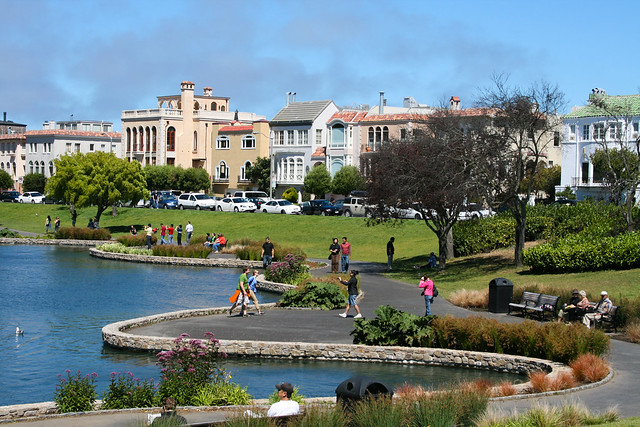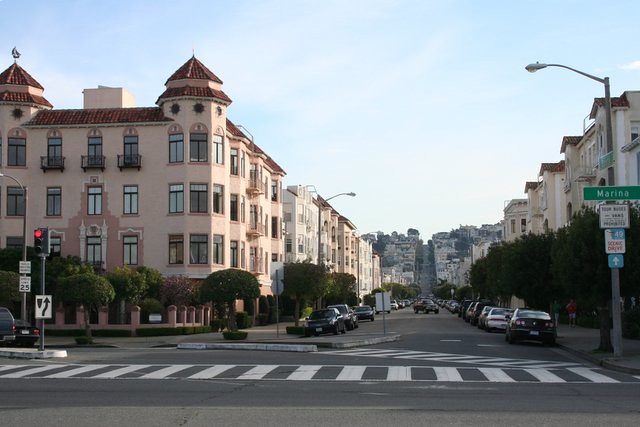The Marina district is situated at the northeastern corner of the Presidio park, bounded on the west by the Palace of Fine Arts, on the east by Van Ness Avenue, to the south by Lombard Street, and of course San Francisco Bay on the north. Much of the city's rubble from the 1906 earthquake was dumped here, along with other landfill. The Palace of Fine Arts is all that remains of the 1915 Panama-Pacific International Exposition, which once took up the entirety of what is now the Marina district.
 |
| Historical image of the 1915 Exposition |
Today the Palace is a popular museum of science and art, the Exploratorium, as well as hosting a 1,000 seat theatre. The rest of the Exposition buildings were demolished and the land sold off to private developers, who built the neighborhood we see today. The 1989 earthquake caused considerable damage due to the soft landfill earth, but the land has since been made more earthquake proof, apparently.
 |
| The western half of the Marina, with the Palace of Fine Arts flanking the western border |
The Marina is a popular area not just for residents but for the whole of the city. It has been called the playground of San Francisco. This trend has intensified since the 1989 earthquake, when much of the neighborhood's middle-class base started to move out to be replaced by young professionals. Today, they make up over half of the population. Here's a funny article from the SF Weekly about Marina types. The marina is host to two yacht clubs and the Marina Green is popular for volleyball and Frisbee. Chestnut Street has dozens of well regarded eateries and restaurants, and Lombard Street is a popular nightlife location. During the day these same areas offer shopping in boutiques, antique shops, and art galleries.
 |
| Marina Boulevard, separating the residential area from the marina and waterfront |
It's certainly nice having all these amenities on the doorstep, but what I'm really interested in is the residential scene. The urbanism and the homes. Already in the above photo we can see a problem. Marina Blvd is a very busy road, not only cutting off the neighborhood from the water but deteriorating the quality of life for adjacent homes. It's practically a highway disguised as an urban street. It's not surprising the Marina has such a large parking lot for cars.
 |
| Homes facing the waterfront. Architecturally not significant, almost like overgrown shacks. |
Things look up elsewhere, though. But first, let me explain how I choose areas to focus on. It's quite simple in actuality. Real estate. In London I came to realize that my favourite parts of the city are generally the most expensive ones. Wealthy individuals are still humans, after all, and are drawn to the nicest areas. Hence that drives the prices up in those areas, further leading to pleasant well-maintained areas. What about those who don't like such areas but instead prefer less expensive "trendy" districts? Well, that has a lot to do with a mental defence mechanism, in my opinion. Those areas are generally trendy because a trendy group of people, such as artists and young professionals, move there because they can't afford the rent in a nicer location. These areas then become fashionable, even take on a snobby air, with scorn placed on those who don't live there. Doubtless these same people move to an area they once derided if/when they come into a bit of money. But back to the Marina.
The most desirable part of the Marina lies away from the busy roads, alongside the Palace. More specifically, a 3-4 block stretch of Baker Street.
 |
| Corner of Baker and North Point Streets |
 |
| Portion of Baker Street facing the Palace. Cow Hollow and Pacific Heights are up the hill in the distance. This particular 1927 5,200 sq ft corner home sold for $7.1 million back in 2007. |
One can come away with the impression that the Marina is sort of like a normal suburb on steroids, a more dense version of a typical pseudo Mediterranean California style neighborhood. It is true that many of the area's most expensive homes are not in the best taste, and are not in fact historical at all but newly built. I would normally frown on such development, but somehow it works for me, here in the Marina under the bright California sun. California is anyway quite a young state, symbol of progressive thinking and beacon for the new. California is built on dreams. Only in California could you get away with this kind of architecture, elsewhere labelled as pastiche (maybe here, too). Put your hair down, laugh it off.
Here's a listing for a home currently on the market for almost $2.7 million. Located on Beach Street, it's just steps away from Baker Street. Nothing extraordinary, but it's not ostentatious and has a good sized rear garden. The garage door is in fact not a garage door but a window into the home. The Palace can be seen to dominate the views from the tree-lined street.
Moving away from Baker Street, and the neighborhood takes on a different persona. More urban, clearly less wealthy but possessing a charm of its own.
 |
| Broderick Street, which runs north/south through the Marina, one block from and parallel to Baker Street. |
 |
| Broderick Street. |
Just one block from Baker Street and what a contrast. Greenery is sparse. Note the larger apartment buildings on street corners, a theme throughout the Marina.
The legacy of the Marina's land division among private developers is evident in the homes, with entire streets often the same style of home. Over the years certain homes have deviated from their original form but most not unrecognisably so. Moving eastward this is more clear, where blocks have more singular styles and massing. There also seems to be a kind of homeowners' association mentality in terms of street aesthetic. Often front yards on a certain street are decorated in a cohesive manner.
 |
| Avila Street encompasses a two block wide row of homes in a similar style, running nearly across the neighborhood from Beach to Lombard Streets. |
 |
| Adjacent to Avila Street is this two block section of the Marina, visible even from above due to its distinct off-the-grid street pattern. |
 |
| Rico Way runs down the middle of these blocks. Note the barrel-fronted homes on the left, a common sight in the Marina. A cohesive street beautification effort seems to be present here. Once again this street reminds one of a suburb. |
 |
| Apartment buildings become more present in the eastern portion of the Marina. Often situated at street corners, they range in style from pre-war Art Deco to undistinguished industrial. |
The Marina is in many ways an inner-ring suburb, which is a fair description considering its location not near but not particularly distant from Downtown. The western portion of the neighborhood is a pleasant, wealthy area with undoubtedly nice homes if a bit too kitsch. Still, it's no surprise the area is popular with young professionals and young families. It's safe, clean, and provides easy access to all kinds of amenities and services. Many residents rarely travel beyond their neighborhood in an average week. I'm not surprised.
 |
| flickr : fridayinla |
 |
| flickr : mykaul |
To close, a few historical photos.
 |
| 1856 |
 |
| 1895 |
Next up, Cow Hollow, that more refined hybrid of Marina and Pacific Heights.





















